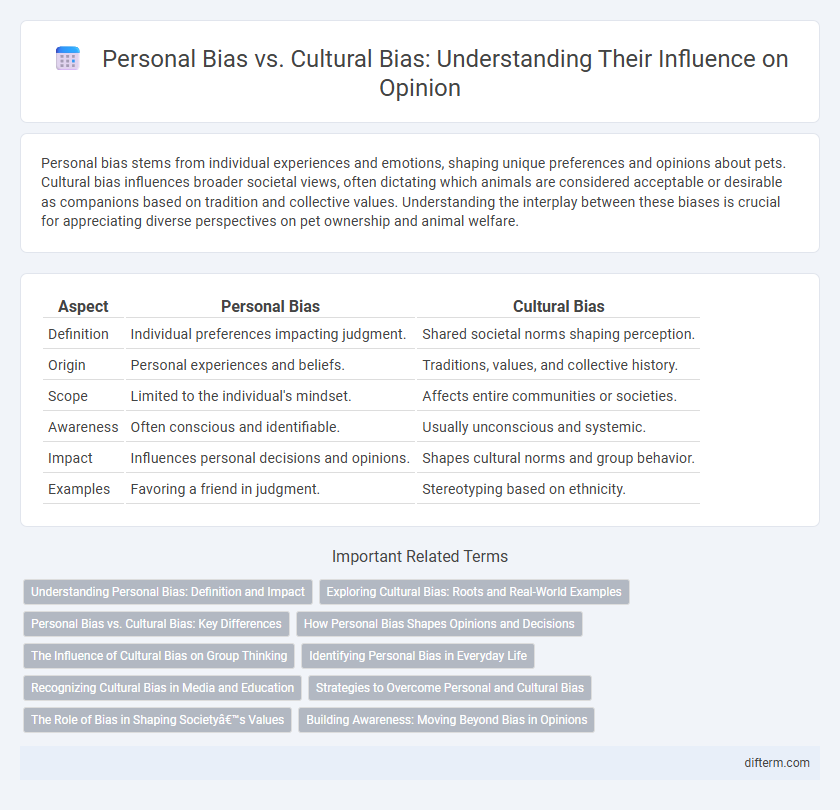Personal bias stems from individual experiences and emotions, shaping unique preferences and opinions about pets. Cultural bias influences broader societal views, often dictating which animals are considered acceptable or desirable as companions based on tradition and collective values. Understanding the interplay between these biases is crucial for appreciating diverse perspectives on pet ownership and animal welfare.
Table of Comparison
| Aspect | Personal Bias | Cultural Bias |
|---|---|---|
| Definition | Individual preferences impacting judgment. | Shared societal norms shaping perception. |
| Origin | Personal experiences and beliefs. | Traditions, values, and collective history. |
| Scope | Limited to the individual's mindset. | Affects entire communities or societies. |
| Awareness | Often conscious and identifiable. | Usually unconscious and systemic. |
| Impact | Influences personal decisions and opinions. | Shapes cultural norms and group behavior. |
| Examples | Favoring a friend in judgment. | Stereotyping based on ethnicity. |
Understanding Personal Bias: Definition and Impact
Personal bias refers to the individual prejudices and preconceived notions shaped by unique experiences and emotions, influencing decision-making and perception. Understanding personal bias is crucial as it often operates unconsciously, distorting objective judgment and contributing to unfair evaluations. Recognizing its impact enables individuals to foster self-awareness, promoting more equitable interactions and reducing the perpetuation of stereotypes.
Exploring Cultural Bias: Roots and Real-World Examples
Cultural bias stems from deeply ingrained societal norms, traditions, and collective experiences that shape perceptions and judgments. It manifests in real-world examples such as gender roles in media representation, disparities in educational testing, and workplace hiring practices influenced by cultural stereotypes. Understanding these systemic roots helps distinguish cultural bias from personal bias, which is more individual and experiential.
Personal Bias vs. Cultural Bias: Key Differences
Personal bias stems from an individual's unique experiences, emotions, and preferences, influencing perceptions and decision-making on a subjective level. Cultural bias arises from the shared beliefs, values, and norms within a group or society, shaping collective viewpoints and behaviors often unconsciously. Understanding the distinction between personal and cultural bias is crucial for promoting self-awareness and fostering intercultural communication.
How Personal Bias Shapes Opinions and Decisions
Personal bias profoundly shapes opinions and decisions by filtering information through individual experiences, emotions, and beliefs, leading to subjective interpretations of reality. This internal lens often overrides objective data, causing preferences and judgments that may not align with broader cultural norms. Recognizing and addressing personal bias is crucial for making balanced decisions and fostering open-mindedness.
The Influence of Cultural Bias on Group Thinking
Cultural bias profoundly shapes group thinking by embedding shared norms and values that influence collective decision-making processes. This form of bias often overrides individual perspectives, leading to conformity and reinforcing existing cultural paradigms within the group. Awareness of cultural bias is essential to foster critical thinking and promote diverse viewpoints in collaborative environments.
Identifying Personal Bias in Everyday Life
Identifying personal bias in everyday life requires self-awareness and critical reflection on one's own beliefs, attitudes, and experiences that shape perception. Personal biases influence decisions and interactions, often unconsciously, distinguishing them from broader cultural biases rooted in societal norms and collective values. Recognizing these biases prompts mindful behavior and fosters objective judgment, enhancing interpersonal understanding and reducing prejudice.
Recognizing Cultural Bias in Media and Education
Recognizing cultural bias in media and education requires critical examination of whose perspectives are prioritized and which voices are marginalized, often reflecting dominant societal norms. Personal bias influences individual interpretation but cultural bias systematically shapes content, framing narratives through the lens of prevailing cultural values and power structures. Addressing cultural bias involves promoting diverse representation and inclusive curricula to foster equitable understanding and reduce misrepresentation.
Strategies to Overcome Personal and Cultural Bias
Strategies to overcome personal and cultural bias include cultivating self-awareness through reflective practices and seeking diverse perspectives to challenge preconceived notions. Engaging in continuous education about different cultures and implicit biases enhances empathy and reduces stereotypes. Encouraging open dialogue in inclusive environments fosters mutual understanding and promotes cognitive flexibility essential for bias mitigation.
The Role of Bias in Shaping Society’s Values
Personal bias influences individual perceptions and decisions, often reflecting unique experiences and preferences that shape immediate social interactions. Cultural bias operates on a broader scale, embedding shared values and norms within societal structures, thus guiding collective behavior and policy-making. The interplay between personal and cultural biases critically shapes society's evolving values, reinforcing certain ideologies while marginalizing others.
Building Awareness: Moving Beyond Bias in Opinions
Personal bias often stems from individual experiences and emotions, while cultural bias reflects collective norms and values that shape group behavior. Building awareness requires recognizing these biases as distinct yet interconnected influences on our opinions. Developing critical thinking and empathy fosters a more balanced perspective that moves beyond both personal and cultural prejudices.
personal bias vs cultural bias Infographic

 difterm.com
difterm.com